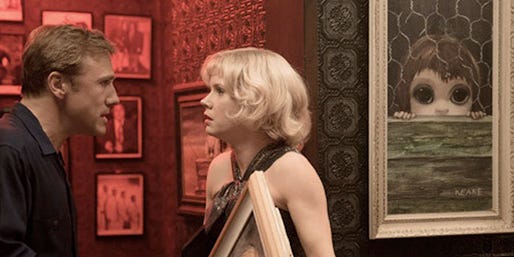Big Eyes

At first blush, “Big Eyes” seems like the least Tim Burton movie Tim Burton could possibly make. It’s a modestly budgeted artist biopic set among the pastel-and-neon chintz of 1960s San Francisco. Save for a handful of minor hallucinations and a brief, tame “Shining” riff, it’s absolutely bereft of otherworldly aesthetics, off-kilter angles or ominous architecture.
However, as “Big Eyes” gradually widens its gaze, it reveals the challenge that certainly lured Burton to it, one that he meets admirably and without abandoning his voice. For the first time since “Batman Returns,” the director broadens his familiar tortured-outsider narrative by considering what those circumstances must feel like for a woman.
On that score, naysayers may accuse Burton of playing it safe with this story of Margaret Keane, a painter whose conniving husband claimed credit for her successful, signature series of melancholy kids with mammoth eyes throughout the 1960s. After all, it’s hardly a surprise to splash around in subtext about art’s subjectivity and women’s subjugation. It dredges up little you may not have considered, but neither does it drown in self-important, sentimental murk.
Yes, Margaret’s work exhibited considerable skill and distinctive technique, but “Big Eyes” thankfully avoids branding her an unsung artistic talent on whom the world missed out. Instead, the movie matches her kitsch with Burton’s kitsch. Albeit flecked with occasionally bruising drama, this is a laugh-out-loud, crowd-pleasing comedy, down to its canny soundtrack choices.
It’s also a welcome return of the usual wry, playful, template-tossing work by screenwriters Scott Alexander and Larry Karaszewki — masters of the offbeat biopic after Burton's “Ed Wood,” “The People vs. Larry Flynt” and “Man on the Moon.” Who’d want a dour, dry depiction of a woman whose work occupied middle ground between dogs playing poker and Georgia O’Keeffe?
We meet Margaret (Amy Adams) as she’s hightailing it from a very “Edward Scissorhands”-looking suburbia. She’s fleeing her abusive husband with only her daughter, Jane, and a proficient, but not terribly marketable, aptitude for painting to her name. To make ends meet, she paints cribs, and cinematographer Bruno Delbonnel’s frisky camera playfully envisions her birthing her career so to speak, framed inside the bones of the furniture.
On weekends, Margaret paints her big-eyed caricatures in the park, where Walter (Christoph Waltz) first spots her. “I’m just a Sunday painter,” shrugs Walter, who’s a Realtor by trade. His boilerplate scenic renderings of Parisian side streets do little to argue his sad-sack point. But boy, can Walter sell them at a steady clip to the ladies strolling on a Saturday while Margaret meagerly accepts pocket change for her more adventuresome art.
As a sweet-talking connoisseur of a counterculture in which she feels like a carpetbagger, Walter also sets Margaret’s heart aflutter. After a brief courtship, he marries her, providing both the nuclear-family stability she needs to keep Jane after a custody scare and the confident salesmanship she lacks to move her unique artwork.
“Are they hobo kids? Are they poor?” asks Walter’s first customer of Margaret’s work, which, intermingled with his own pieces and signed “Keane,” the patron mistakes for his creation. It’s an easily rectified misunderstanding, but Walter’s response reveals his true nature. “No one wants lady art,” he rationalizes to Margaret, further asserting that if the brushstrokes are hers and the bluster is his, collectively “they are Keane,” so what does it matter?
But as their empire grows, Margaret’s one-time sweetheart becomes her Svengali and the story takes on the shades of a grim domestic fairytale. Lest the secret spill, Walter locks Margaret away like Rapunzel in her studio, where she churns out hits much to the consternation of the cognoscenti (embodied by Terence Stamp and Jason Schwartzman). Only after many years does Walter’s hubris create an opening for Margaret to prove her role and reclaim her dignity.
Unsurprisingly, Walter fits right into Waltz’s rogue gallery of gleefully scabrous cads. The actor specializes in men whose wild prevarications take on a welterweight’s bob-and-weave rhythm, and in the especially enjoyable third act, Waltz feels downright vaudevillian. To say he chews the scenery suggests he hasn’t already torn it down and chucked it into a ravine. And yet it’s never once a one-note performance. It’s three familiar chords, strummed by a master. Waltz always keeps sight of the curdled, recognizably human desperation in Walter, who may have been dishonest with Margaret longer than she suspected but certainly never set out to be her predator.
Whether affectionate or antagonistic, Adams matches Waltz in every scene. “I’ve never made a decision freely,” Margaret says, and we sense a wildness beneath her wispiness. As purposefully calm counterpoint to Waltz’s bombast, Adams’ restrained, relatable turn anchors the film in a reality of personal ache and social alienation. You also visually sense the weight driving her down as the years wear on, to a point where you simply know a significant shift in style is a self-portrait before she says it — diminished, thin, marginalized on the canvas. Of course, Adams sells the joyous lifting of that burden as well as its hardships and puts the right amount of spin on silly lines like “Is Jehovah OK with suing?”
“Big Eyes” falls into that sort of “automatic awards contender” slot simply by association with its leads’ seven Oscar nominations and two wins. The movie is many things — kooky, punchy, peppy, poignant and powerfully acted — but it’s decidedly not that. Disabuse yourself of that notion, and simply enjoy the loose, limber work of a director uncovering newly wondrous ways to entertain.


